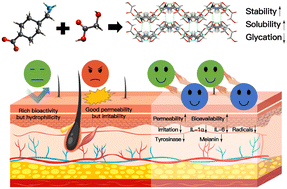Due to its rich bioactivities, tranexamic acid (TA) has garnered significant attention in the biomedical and cosmetic fields. However, TA's hydrophilic nature impedes its penetration through the skin's stratum corneum. This limitation is addressed in the current study by designing a supramolecular TA, i.e., GATA, based on the non-covalent interactions between TA and glycolic acid (GA). The structure and formation mechanism of GATA are explored using multidimensional characterization techniques, including single crystal analysis and computer-aided simulations. In vitro, the supramolecular interactions within GATA facilitate deeper TA penetration into the skin, achieving >2.5 times improved transdermal permeability than pure TA. Notably, GATA does not damage the skin barrier, with the associated irritation and cytotoxicity significantly lower than that caused by GA. Moreover, compared with TA, GATA has comparable or superior thermal stability, water solubility, anti-glycation, antioxidant, and anti-inflammatory properties. GATA also exhibits excellent skin whitening efficacy. Hence, GATA is a promising alternative to TA, with enhanced permeability, bioactivity, and biosafety, as well as considerable application prospects in transdermal delivery.
